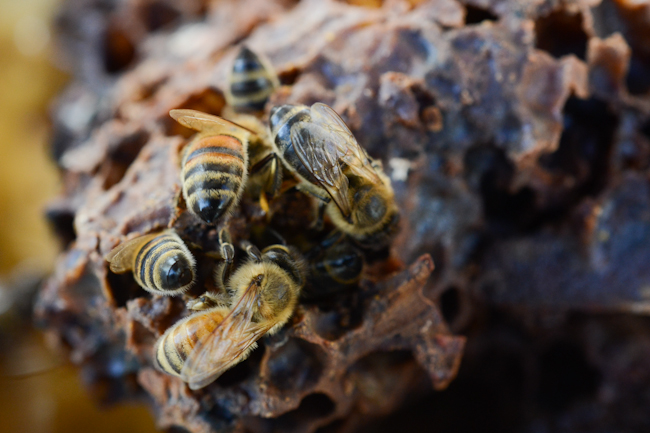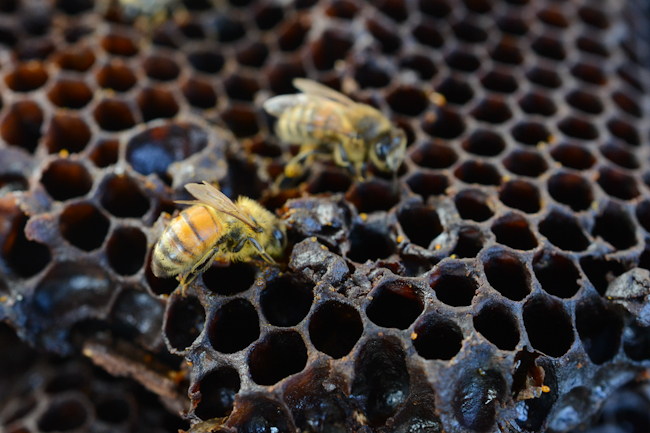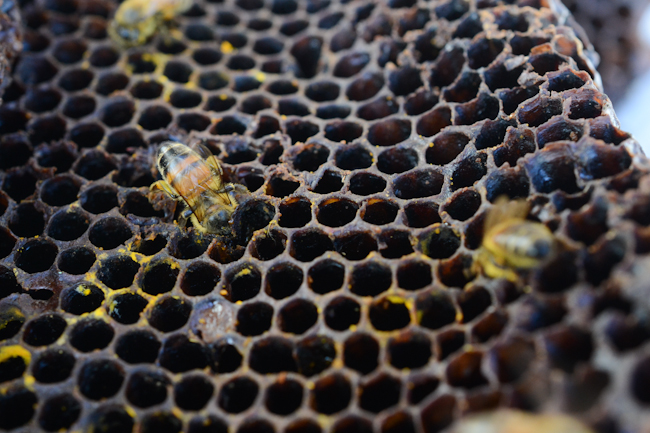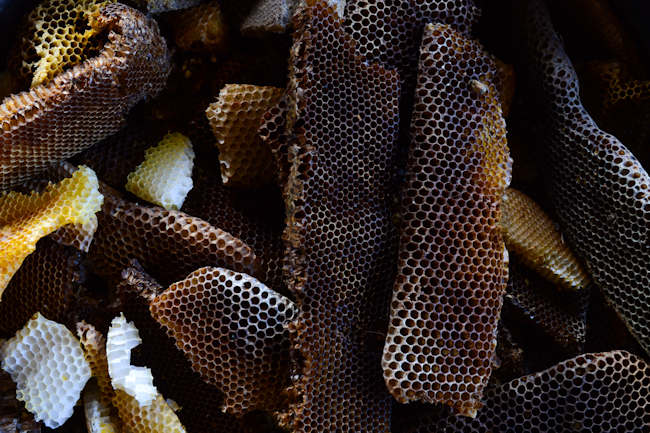
Honeybee’s comb is about the coolest stuff ever. It’s beautiful, functional, symmetrical, and it smells good to boot. Comb is also a wonderfully multipurpose substance. It provides structure for a hive, the right nooks and conditions for rearing brood, and storage space for pollen and of course, honey.
Bees have four pairs of glands on their abdomen that secrete wax flakes that young bees pick off, chew up, and mold into comb. The color of new comb depends on current nectar sources, the race of honeybees in the hive, how much/what type of pollen they’re collecting, and other factors, but new comb is typically white, though in some cases, bees can make bright yellow comb. As the same comb is used over and over, it will darken in color.

Bees draw comb cells in two different sizes to fit incubating worker brood and larger drone brood. The circumstances within the hive at any given time will dictate what structures the bees themselves feel like they need, and they will build accordingly. Often times, the decisions that the worker bees make are in conflict with what a beekeeper thinks is best for the hive. Managed hives must be observed often so that beekeepers can make physical adjustments that will encourage bees to behave in line with the beekeeper’s management plan.


The same worker brood cells can be used to rear a new batch of bees roughly once a month (generally only in the warmer months here in Western Oregon), and in many cases, the same comb will be used for many years. After each batch of new bees hatches, clean-up workers will come in, (ideally) pitching any unhatched larvae and polishing each cell with a thin layer of propolis to prepare it for the next round of eggs or honey stores.
Bees must have a current nectar source in order to draw new comb. Rarely, they will tear down old comb and reconfigure it for their most pressing needs.

Currently, we have a pretty huge stash of comb stored in buckets around the homestead. Most of the irregular chunks have come from extractions Henry performed last year. Henry also cut out large strips of primarily drone comb when he needed to remove bottom spacers from a few hives in an effort to create uniform boxes to take to almond pollination in California. There’s a bit of honey residue and pollen left clinging to some of the wax in the discard pile, so the buckets of comb still draw a crowd of bees snooping around looking for a bit of something to eat.
The plan is to build a solar wax melter eventually, so we can distill all this comb down to solid blocks of wax, and then we will…do SOMETHING with it (not quite sure what yet).
Comb
Honeybee’s comb is about the coolest stuff ever. It’s beautiful, functional, symmetrical, and it smells good to boot. Comb is also a wonderfully multipurpose substance. It provides structure for a hive, the right nooks and conditions for rearing brood, and storage space for pollen and of course, honey.
Bees have four pairs of glands on their abdomen that secrete wax flakes that young bees pick off, chew up, and mold into comb. The color of new comb depends on current nectar sources, the race of honeybees in the hive, how much/what type of pollen they’re collecting, and other factors, but new comb is typically white, though in some cases, bees can make bright yellow comb. As the same comb is used over and over, it will darken in color.
Bees draw comb cells in two different sizes to fit incubating worker brood and larger drone brood. The circumstances within the hive at any given time will dictate what structures the bees themselves feel like they need, and they will build accordingly. Often times, the decisions that the worker bees make are in conflict with what a beekeeper thinks is best for the hive. Managed hives must be observed often so that beekeepers can make physical adjustments that will encourage bees to behave in line with the beekeeper’s management plan.
The same worker brood cells can be used to rear a new batch of bees roughly once a month (generally only in the warmer months here in Western Oregon), and in many cases, the same comb will be used for many years. After each batch of new bees hatches, clean-up workers will come in, (ideally) pitching any unhatched larvae and polishing each cell with a thin layer of propolis to prepare it for the next round of eggs or honey stores.
Bees must have a current nectar source in order to draw new comb. Rarely, they will tear down old comb and reconfigure it for their most pressing needs.
Currently, we have a pretty huge stash of comb stored in buckets around the homestead. Most of the irregular chunks have come from extractions Henry performed last year. Henry also cut out large strips of primarily drone comb when he needed to remove bottom spacers from a few hives in an effort to create uniform boxes to take to almond pollination in California. There’s a bit of honey residue and pollen left clinging to some of the wax in the discard pile, so the buckets of comb still draw a crowd of bees snooping around looking for a bit of something to eat.
The plan is to build a solar wax melter eventually, so we can distill all this comb down to solid blocks of wax, and then we will…do SOMETHING with it (not quite sure what yet).